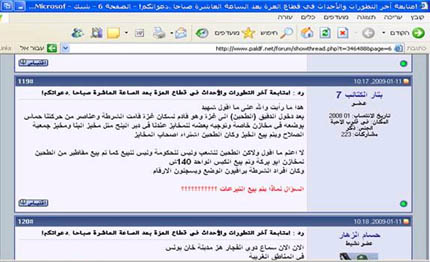CAMERA has now updated its analysis of the Goldstone Report--The Goldstone Report: A Study in Duplicity--to include a refutation of the claim that Israel's attack of the Al Bader flour mill was intended to deprive Gazans of food:
Elsewhere in the Report, similar nefarious motives were attributed to the Israel, even in military operations where no Palestinian civilians were reported killed or injured.:The Goldstone Report is consistent that way.Original: 50. ...The Mission... finds that [Israel's] destruction of the [Al Bader] mill was carried out for the purposes of denying sustenance to the civilian population, which is a violation of customary international law and may constitute a war crime.
Final version: 50. ..The Mission...finds that the destruction of the mill was carried out to deny sustenance to the civilian population, which is a violation of customary international law and may constitute a war crime.
No one was reported injured or killed during this Israeli operation. The Report acknowledges that the mill was the tallest building in the area, that Israeli troops occupied and used the upper floors of the mill after the airstrike, and that, during the operation in general, Israel felt that “because roads and buildings were often mined, IDF forces had to target them to protect themselves.” A rational observer would therefore conclude that the mill was not fired on for the purposes of denying sustenance, but rather in order to clear potential mines and fighters from a high-ground military objective that Israel deemed important to occupy during the fighting.
That Israel's attack was "for the purposes of denying sustenance to the civilian population" is further belied by the fact that the country actually increased humanitarian aid, which includes food aid, to the Palestinians during Operation Cast Lead.
During Operation Cast Lead, the following humanitarian aid was transferred from Israel into Gaza:
37,159 tons of humanitarian aid on 1503 trucks were transferred via the Kerem Shalom and Karni crossings (food, medication and medical supplies)
1,535,750 liters of heavy duty diesel for the Gaza power station
234 tons of gas for domestic use
188,000 liters of diesel for UNRWA vehicles and needs
3,896 tons of grain, on 98 trucks were transferred via the Karni conveyor belt
Even on January 9 — the day Israel was said to have taken over the Al Bader mill — 41 trucks carrying food products and electrical equipment entered Gaza via Israel's Kerem Shalom crossing. And over the following week, 622 more trucks carrying more than 15,000 tons of food, medical supplies and humanitarian aid were transferred to the territory.
A screen capture of a Hamas internet forum where surfers complained about flour donations being confiscated in Dir-al'Balech by Hamas gunmen.
Indeed, Israel points out that it transfered 14,208 tons of flour into Gaza during the war, or an average of 618 tons/day. Not only is this quantity significantly more flour than the 220 metric tons the Al Bader mill could have produced in a day; but more strikingly, it is well over the 450 tons/day that the UN and the World Food Programme say Gaza needs.
Israel also implemented a daily humanitarian recess (ceasefire) in order to facilitate the transfer of humanitarian supplies.
Meanwhile, Hamas was stealing some of those humanitarian shipments, including food and flour, leading UN Secretary General Ban Ki Moon to tell Hamas it must "refrain from interference with the provision and distribution of humanitarian assistance in Gaza." Israel also noted Palestinian reports that Hamas operatives seized bags of donated flour to sell at outrageous prices.
The Goldstone commission, however, did not let facts get in the way of implying motive in order to charge Israel with war crimes.
Technorati Tag: Goldstone Report and Al Bader Flour Mill.


No comments:
Post a Comment